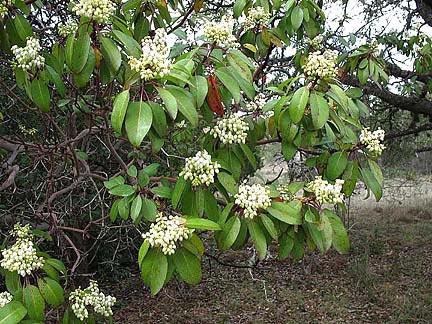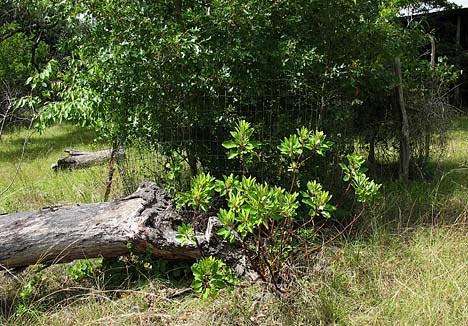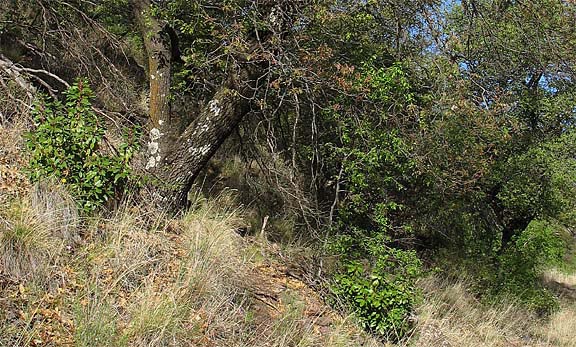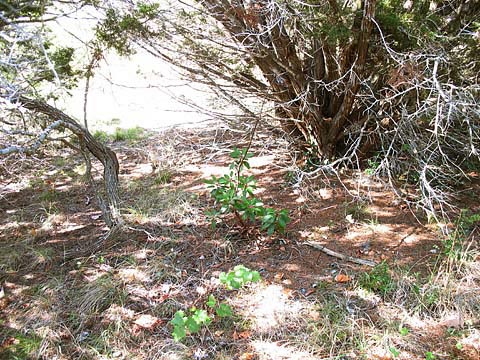by Bob Harms

The Madrone — Juniper Association
In the eastern hillcountry the madrone—juniper association is well known.
The Myth of Microorganisms
Madrones are found in the wild only in close association with Ashe junipers, generally in Glen Rose limestone formations. A number of myths concerning this relationship are widely held. Perhaps the most common is the belief that madrones require the presence of microorganisms fostered by the junipers. Although this view has an attractive scientific ring to it, in fact no research has ever established such a relationship for these two species.
My own experience doesn't support the presence of Ashe junipers as a necessary factor. Juniper mulch serves as a valuable medium for germination, but is not essential.
- My initial seedlings, from which our own entire population stems, were grown in soil gathered from an open undeveloped area above Barton Creek in SW Austin — but not from under junipers.
- The largest madrones that survived from these seedlings were placed in the ground in areas with no junipers; as seedlings with only a few true leaves. [Note the history of our largest madrone.]

Our second largest madrone, planted as a seedling between two live oaks (and protected from leaf litter).
- Madrone seedlings from berries of our initial population have volunteered in areas not adjacent to junipers, including under oaks where leaf litter has been removed and grass has been mowed.

Under a large Spanish oak, which has now died.
- In the Davis Mountains madrones are common on hillsides with no junipers.

Young madrones in the Davis Mountains — no junipers in sight.
My Views
I have a somewhat different explanation of the madrone—juniper association. One aspect of this association is fortuitous:
- Madrones in Central Texas are only found on Glen Rose formations along the Balcones Escarpment — an area heavily populated with Ashe juniper. My claim is that the rock formations of the Glen Rose provide the stable environment necessary for madrone roots, in contrast with the heavy clay soils of the valleys and prairies in Central Texas. The only madrones of mine that have died (apart from armadillo digging) were in deep clay following a period of expansion and contraction.
More direct significant factors are:
- Junipers provide filtered shade without leaf litter that would bury young seedlings. Needles never fall in quantities that would affect very small seedlings, especially in very early spring. On the other hand, live oaks produce masses of leaf litter at just the time when madrone seeds would be germinating.
- The juniper mulch absorbs much of a rainfall. After an apparent soaking rain, the mulch is often strangely dry. This is not because of the juniper canopy — one wouldn't stand under a juniper to avoid getting wet, and the juniper drip line is nonexistent. Only a significant rainfall would insure a sufficiently moist juniper mulch environment that would both favor germination and guarantee continued moisture for initial growth.
-
Madrones do not volunteer in open grassland areas. These are too dry and the soil is too heavy. But when junipers have been permitted to grow large in the open areas, madrones have begun appearing in the juniper mulch. My interpretation of this is that in addition to the general juniper environments noted above, the shade and juniper mulch constrain the expansion/contraction of the clay soil that often proves deadly to young madrones. The juniper roots may also play a role in stabilizing the soil.

Recent volunteer under juniper in earlier grassy area.
Plant Resources Center Home Page — Flora of Texas
— Ashe Juniper — Texas Madrone





